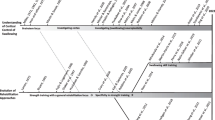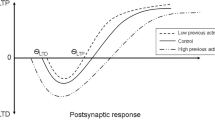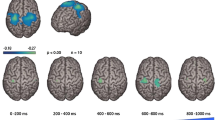Abstract
Recent research has suggested that the central nervous system controlling swallowing can undergo experience-dependent plasticity. Moreover, swallowing neuroplastic change may be associated with behavioural modulation. This article presents research evidence suggesting that nonbehavioural and behavioural interventions, as well as injury, can induce swallowing neuroplasticity. These studies indicate that while swallowing and limb neuroplasticity share certain features, certain principles of swallowing neuroplasticity may be distinct. Thus, an understanding of swallowing neuroplasticity is necessary in terms of explaining and predicting the (1) behavioural effects of injury to the swallowing nervous system and (2) effects of swallowing interventions applied in rehabilitation.

Similar content being viewed by others
References
Adachi K, Lee J, Hu JW, Yao D, Sessle BJ. Motor cortex neuroplasticity associated with lingual nerve injury in rats. Somatosens Mot Res. 2007;24:97–109. doi:10.1080/08990220701470451.
Avivi-Arber L, Lee J, Sessle BJ. Motor cortex (MI) neuroplasticity may result from extraction of rat mandibular incisor. Soc Neurosci Abstr. 2005;174:2.
Bauer S, Hay M, Amilhon B, Jean A, Moyse E. In vivo neurogenesis in the dorsal vagal complex of the adult rat brainstem. Neuroscience. 2005;130:75–90. doi:10.1016/j.neuroscience.2004.08.047.
Bonham AC, Chen CY, Sekizawa S, Joad JP. Plasticity in the nucleus tractus solitarius and it influence on lung and airway reflexes. J Appl Physiol. 2006;101:322–7. doi:10.1152/japplphysiol.00143.2006.
Boudreau S, Romaniello A, Wang K, Svensson P, Sessle BJ, Arendt-Nielsen L. The effects of intra-oral pain on motor cortex neuroplasticity associated with short-term novel tongue-protrusion training in humans. Pain. 2007;132:169–78. doi:10.1016/j.pain.2007.07.019.
Bove M, Mansson I, Eliasson I. Thermal oral-pharyngeal stimulation and elicitation of swallowing. Acta Otolaryngol. 1998;118:728–31. doi:10.1080/00016489850183269.
Brown JA. Recovery of motor function after stroke. Prog Brain Res. 2006;157:223–8.
Butefisch CM, Khurana V, Kopylev L, Cohen LG. Enhancing encoding of a motor memory in the primary motor cortex by cortical stimulation. J Neurophysiol. 2004;91:2110–6. doi:10.1152/jn.01038.2003.
Calautti C, Baron JC. Functional neuroimaging studies of motor recovery after stoke in adults. Stroke. 2003;34:1553–66. doi:10.1161/01.STR.0000071761.36075.A6.
Calautti C, Naccarato M, Jones PS, Sharma N, Day DD, Carpenter AT, et al. The relationship between motor deficit and hemisphere activation balance after stroke: a 3T fMRI study. Neuroimage. 2007;34:322–31. doi:10.1016/j.neuroimage.2006.08.026.
Chen R, Cohen LG, Hallett M. Nervous system reorganization following injury. Neuroscience. 2002;111:761–73. doi:10.1016/S0306-4522(02)00025-8.
Constantine-Paton M. Pioneers of cortical plasticity: six classic papers by Wiesel and Hubel. J Neurophysiol. 2008;99:2741–4. doi:10.1152/jn.00061.2008.
Coulas VL, Smith RC, Qadri SS, Martin RE, Differentiating effortful and noneffortful swallowing with a neck force transducer: implications for the development of a clinical feedback system. Dysphagia 2008; 23:000–000, doi:10.1007/s00455-008-9157-0.
Cramer SC, Nelles G, Benson RR, Kaplan JD, Parker RA, Kwong KK, et al. A fuctional MRI study of subjects recovered from hemiparetic stoke. Stroke. 1997;28:2518–27.
Dubner R, Sessle BJ, Storey AT. The Neural Basis of Oral and Facial Function. New York: Plenum Press; 1978.
El Sharkawi A, Ramig L, Logemann JA, Pauloski BR, Rademaker AW, Smith CH, et al. Swallowing and voice effects of Lee Silverman Voice Treatment (LSVT): a pilot study. J Neurol Neurosurg Psychiatry. 2002;72:31–6. doi:10.1136/jnnp.72.1.31.
Ellrich J. Electric low-frequency stimulation of the tongue induces long-term depression of the jaw-opening reflex in anesthetized mice. J Neurophysiol. 2004;92:3332–7. doi:10.1152/jn.00156.2004.
Fitzgerald PB, Benitez J, de Castella A, Daskalakis ZJ, Brown TL, Kulkuni J. A randomized, controlled trial of sequential bilateral repetitive transcranial magnetic stimulation for treatment-resistant depression. Am J Psychiatry. 2006;163:88–94. doi:10.1176/appi.ajp.163.1.88.
Fraser C, Power M, Hamdy S, Rothwell J, Hobday D, Hollander I, et al. Driving plasticity in human adult motor cortex is associated with improved motor function after brain injury. Neuron. 2002;34:831–40. doi:10.1016/S0896-6273(02)00705-5.
Fraser C, Rothwell J, Power M, Hobson A, Thompson D, Hamdy S. Differential changes in human pharyngoesophageal motor excitability induced by swallowing, pharyngeal stimulation, and anesthesia. Am J Physiol Gastrointest Liver Physiol. 2003;285:G137–44.
Godde B, Ehrhardt J, Braun C. Behavioral significance of input-dependent plasticity of human somatosensory cortex. NeuroReport. 2003;14:543–6. doi:10.1097/00001756-200303240-00002.
Gow D, Rothwell JC, Hobson A, Thompson D, Hamdy S. Induction of long-term plasticity in human swallowing motor cortex following repetitive cortical stimulation. Clin Neurophysiol. 2004;115:1044–51. doi:10.1016/j.clinph.2003.12.001.
Halkjaer L, Melsen B, McMillan AS, Svensson P. Influence of sensory deprivation and perturbation of trigeminal afferent fibers on corticomotor control of human tongue musculature. Exp Brain Res. 2006;170:199–205. doi:10.1007/s00221-005-0199-3.
Hallett M. Neuroplasticity and rehabilitation. J Rehabil Res Dev. 2005;42:xvii–xii.
Hamdy S, Rothwell JC, Aziz Q, Singh KD, Thompson DG. Long-term reorganization of human motor cortex driven by short-term sensory stimulation. Nat Neurosci. 1998;1:64–68.
Hamdy S, Rothwell JC. Gut feelings about recovery after stroke: the organization and reorganization of human swallowing motor cortex. Trends Neurosci. 1998;21:278–82. doi:10.1016/S0166-2236(97)01212-5.
Hamdy S, Aziz Q, Rothwell JC, Singh KD, Barlow J, Hughes DG, et al. The cortical topography of human swallowing musculature in health and disease. Nat Med. 1996;2:1217–24. doi:10.1038/nm1196-1217.
Hamdy S, Aziz Q, Rothwell JC, Power M, Singh KD, Nicholson DA, et al. Recovery of swallowing after dysphagic stroke relates to functional reorganization in the intact motor cortex. Gastroenterology. 1998;115:1104–12. doi:10.1016/S0016-5085(98)70081-2.
Hamdy S, Jilani S, Price V, Parker C, Hall N, Power M. Modulation of human swallowing behaviour by thermal and chemical stimulation in health and after brain injury. Neurogastroenterol Motility. 2003;15:69–77. doi:10.1046/j.1365-2982.2003.00390.x.
Hebb DO. The organization of behaviour. New York: Wiley; 1949.
Hind JA, Nicosia MA, Roecker EB, Carnes ML, Robbins J. Comparison of effortful and noneffortful swallows in healthy middle-aged and older adults. Arch Phys Med Rehabil. 2001;82:1661–5.
Huang YZ, Edwards MJ, Rounis E. Bhalia KP, Rothwell JC. Theta burst stimulation of the human motor cortex. Neuron. 2005;45:201–6. doi:10.1016/j.neuron.2004.12.033.
Huckabee ML, Butler SG, Barclay M, Jit S. Submental surface electromyographic measurement and pharyngeal pressures during normal and effortful swallowing. Arch Phys Med Rehabil. 2005;86:2144–9. doi:10.1016/j.apmr.2005.05.005.
Hummel FC, Cohen LG. Drivers of brain plasticity. Curr Opin Neurol. 2005;18:667–74. doi:10.1097/01.wco.0000189876.37475.42.
Jefferson S, Mistry S, Hancock L, Rothwell JC, Hamdy S. Reversing a virtual lesion in human swallowing motor cortex with cortical stimulation: a model for dysphagia after stroke? Gut. 2008;57(Suppl 1):A11.
Kern MK, Jaradeh S, Arndofer RC, Shaker R. Cerebral cortical representation of reflexive and volitional swallowing in humans. Am J Gastrointest Liver Physiol. 2001;280:G354–60.
Kim YH, You SH, Ko MH, Park JW, Lee KH, Jang SH, et al. Repetitive transcranial magnetic stimulation-induced corticomotor excitability and associated motor skill acquisition in chronic stroke. Stroke. 2006;37:1471–6. doi:10.1161/01.STR.0000221233.55497.51.
Kleim JA, Jones TA. Principles of experience-dependent neural plasticity: implications for rehabilitation after brain damage. J Speech Lang Hear Res. 2008;51:S225–39. doi:10.1044/1092-4388(2008/018).
Lazarus C, Logemann JA, Huang CF, Rademaker AW. Effects of two types on tongue strengthening exercises in young normals. Folia Phoniatr Logop. 2003;55:199–205. doi:10.1159/000071019.
Lazzara G, Lazarus C, Logemann JA. Impact of thermal stimulation on the triggering of the swallowing reflex. Dysphagia. 1986;1:73–7. doi:10.1007/BF02407117.
Lin LD, Murray GM, Sessle BJ. Functional properties of single neurons in the primate face primary somatosensory cortex. I. Relations with trained orofacial motor behaviors. J Neurophysiol. 1994;71:2377–90.
Liu XG, Morton CR, Azkue JJ, Zimmermann M, Sandkühler J. Long-term depression of C-fibre-evoked spinal field potentials by stimulation of primary afferent a delta-fibers in the adult rat. Eur J NeuroSci. 1998;10:3069–75. doi:10.1046/j.1460-9568.1998.00310.x.
Luber B, Peterchev AV, Nguyen T, Sporn A, Lisanby SH. Application of transcranial magnetic stimulation (TMS) in psychophysiology. In: Cacioppo JT, Tassinary LG, Berntson GG, editors. Handbook of Psychophysiology, 3rd ed. Cambridge: Cambridge University Press; 2007. p. 120–38.
Ludlow CL, Humbert I, Saxon K, Poletto C, Sonies B, Crujido L. Effects of surface electrical stimulation both at rest and during swallowing in chronic pharyngeal dysphagia. Dysphagia. 2007;22:1–10. doi:10.1007/s00455-006-9029-4.
Malcolm MP, Triggs WJ, Light KE, Gonzalez Rothi LJ, Wu S, Reid K, et al. Repetitive transcranial magnetic stimulation as an adjunct to constrain-induced therapy: an exploratory randomized controlled trial. Am J Phys Med Rehabil. 2007;86:707–15. doi:10.1097/PHM.0b013e31813e0de0.
Mansur CG, Fregni F, Boggio PS, Riberto M, Gallucci-Neto J, Santos CM, et al. A sham stimulation-controlled trial of rTMS of the unaffected hemisphere in stroke patients. Neurology. 2005;64:1802–4. doi:10.1212/01.WNL.0000161839.38079.92.
Mark VW, Taub E, Morris DM. Neuroplasticity and constraint-induced movement therapy. Eura Medicophys. 2006;42:269–84.
Martin RE, Sessle BJ. The role of the cerebral cortex in swallowing. Dysphagia. 1993;8:195–202. doi:10.1007/BF01354538.
Martin RE, Murray GM, Kemppainen P, Masuda Y, Sessle BJ. Functional properties of neurons in the primate tongue primary motor cortex during swallowing. J Neurophysiol. 1997;78:1516–30.
Martin RE, Kemppainen P, Masuda Y, Yao D, Murray GM, Sessle BJ. Features of cortically evoked swallowing in the adult primate (Macaca fascicularis). J Neurophysiol. 1999;82:1529–41.
Martin RE, Goodyear BG, Gati JS, Menon RS. Cerebral cortical representation of automatic and volitional swallowing in humans. J Neurophysiol. 2001;85:938–50.
Martin RE, MacIntosh BJ, Smith RC, Barr AM, Stevens TK, Gati JS, et al. Cerebral areas processing swallowing and tongue movement are overlapping but distinct: a functional magnetic resonance study. J Neurophysiol. 2004;92:2428–43. doi:10.1152/jn.01144.2003.
Martin R, Barr A, MacIntosh B, Smith R, Stevens T, Taves D, et al. Cerebral cortical processing of swallowing in older adults. Exp Brain Res. 2007;176:12–22. doi:10.1007/s00221-006-0592-6.
Mistry S, Rothwell JC, Thompson DG, Hamdy S. Modulation of human cortical swallowing motor pathways after pleasant and aversive taste stimuli. Am J Physiol Gastrointest Liver Physiol. 2006;291:G666–71. doi:10.1152/ajpgi.00573.2005.
Mistry S, Verin E, Singh S, Jefferson S, Rothwell JC, Thompson DG, et al. Unilateral suppression of pharyngeal motor cortex to repetitive transcranial magnetic stimulation reveals functional asymmetry in the hemispheric projections to human swallowing. J Physiol. 2007;585:525–38. doi:10.1113/jphysiol.2007.144592.
Moucha R, Kilgard MP. Cortical plasticity and rehabilitation. Prog Brain Res. 2006;157:111–22.
Muellbacher W, Artner C, Mamoli B. The role of the intact hemisphere in recovery of midline muscles after recent monohemispheric stroke. J Neurol. 1999;246:250–6. doi:10.1007/s004150050343.
Muellbacher W, Boroojerdi B, Ziemann U, Hallett M. Analogous corticocortical inhibition and facilitation in ipsilateral and contralateral human motor cortex representation of the tongue. J Clin Neurophysiol. 2001;18:550–8. doi:10.1097/00004691-200111000-00005.
Murray GM, Sessle BJ. Functional properties of single neurons in the face primary motor cortex of the primate. II. Relations with trained orofacial motor behavior. J Neurophysiol. 1992;67:759–74.
Nudo RJ, Frost SB. The evolution of motor cortex and motor systems. In: Krubitzer LA, Kass JH, editors. Evolution of Nervous Systems in Mammals. Oxford, UK: Elsevier; 2006.
Nudo RJ, Milliken GW. Reorganization of movement representations in primary motor cortex following focal ischemic infarcts in adult squirrel monkeys. J Neurophysiol. 1996;75:2144–9.
Nudo RJ, Plautz EJ, Frost SB. Role of adaptive plasticity in recovery of function after damage to motor cortex. Muscle Nerve. 2001;24:1000–19. doi:10.1002/mus.1104.
Oh BM, Kim DY, Paik NJ. Recovery of swallowing function is accompanied by the expansion of the cortical map. Int J Neurosci. 2007;117:1215–27. doi:10.1080/00207450600936254.
Paine PA, Hamdy S, Chitnis X, Gregory LJ, Giampietro V, Brammer M, et al. Modulation of activity in swallowing motor cortex following esophageal acidification: a functional magnetic resonance imaging study. Dysphagia. 2008;23:146–54. doi:10.1007/s00455-007-9114-3.
Pascual-Leone A. Disrupting the brain to guide plasticity and improve behavior. Prog Brain Res. 2006;157:315–29.
Pascual-Leone A, Valls-Sole J, Wassermann EM, Hallett M. Responses to rapid-rate transcranial magnetic stimulation of the human motor cortex. Brain. 1994;117:847–58. doi:10.1093/brain/117.4.847.
Pascual-Leone A, Amedi A, Fregni F, Merabet LB. The plastic human brain cortex. Annu Rev Neurosci. 2005;28:377–401. doi:10.1146/annurev.neuro.27.070203.144216.
Power M, Fraser C, Hobson A, Rothwell JC, Mistry S, Nicholson DA, et al. Changes in pharyngeal corticobulbar excitability and swallowing behavior after oral stimulation. Am J Physiol Gastrointest Liver Physiol. 2004;286:G45–50. doi:10.1152/ajpgi.00114.2003.
Power M, Fraser C, Hobson A, Singh S, Tyrrell P, Nicholson D, et al. Evaluating oral stimulation as a treatment for dysphagia after stroke. Dysphagia. 2006;21:49–55. doi:10.1007/s00455-005-9009-0.
Raymont V, Grafman J. Cognitive neural plasticity during learning and recovery from brain damage. Prog Brain Res. 2006;157:199–206.
Rijntjes M, Tegenthoff M, Liepert J, Kotterba S, Muller S, Kiebel S, et al. Cortical reorganization in patients with facial palsy. Ann Neurol. 1997;41:621–30. doi:10.1002/ana.410410511.
Robbins J, Kays SA, Gangnon RE, Hind JA, Hewitt AL, Gentry LR, et al. The effects of lingual exercise in stroke patients with dysphagia. Arch Phys Med Rehabil. 2007;88:150–8. doi:10.1016/j.apmr.2006.11.002.
Robbins J, Butler SG, Daniels SK, Diez Gorss R, Langmore S, Lazarus CL, et al. Swallowing and dysphagia rehabilitation: translating principles of neural plasticity into clinically oriented evidence. J Speech Lang Hear Res. 2008;51:S276–300. doi:10.1044/1092-4388(2008/021).
Rodel RMW, Markus H, Tergau F, Laskawi R. Bilateral changes in cortical motor representation of the tongue after unilateral peripheral facial paralysis: evidence from transcranial magnetic stimulation. Ann Otol Rhinol Laryngol. 2004;113:951–5.
Rosenbek JC, Donovan NJ. Plasticity in the neural pathways for swallowing: the role in rehabilitation of dysphagia. In: Selzer ME, Cohen L, Gage FH, Clark S, Duncan PW, editors. Textbook of neural repair and rehabilitation. Volume II Medical Neurorehabilitation. Cambridge: Cambridge University Press; 2005. p. 356–67.
Rosenbek JC, Robbins J, Willford WO, Kirk G, Schiltz A, Sowell TW, et al. Comparing treatment intensities of tactile-thermal application. Dysphagia. 1998;13:1–9. doi:10.1007/PL00009542.
Rosenkranz K, Kacar A, Rothwell JC. Differential modulation of motor cortical plasticity and excitability in early and late phases of human motor learning. J Neurosci. 2007;27:12058–66. doi:10.1523/JNEUROSCI.2663-07.2007.
Rossini PM, Calautti C, Pauri F, Baron JC. Post-stroke plastic reorganization in the adult brain. Lancet Neurol. 2003;2:493–502. doi:10.1016/S1474-4422(03)00485-X.
Rothwell JC. Techniques and mechanisms of action of transcranial stimulation of the human motor cortex. J Neurosci Methods. 1997;74:113–22. doi:10.1016/S0165-0270(97)02242-5.
Rothwell JC, Rozenkranz K. Role of afferent input in motor organization in health and disease. Achieving sensory motor reorganization without active motor output. Eng Med Biol Mag IEEE. 2005;24:40–4. doi:10.1109/MEMB.2005.1384099.
Sanes JN, Donoghue JP. Plasticity and primary motor cortex. Annu Rev Neurosci. 2000;23:393–415. doi:10.1146/annurev.neuro.23.1.393.
Sapienza CM, Wheeler K. Respiratory muscle strength training: functional outcomes versus plasticity. Semin Speech Lang. 2006;27:236–44. doi:10.1055/s-2006-955114.
Schorr A, Ellrich J. Long-term depression of the human blink reflex. Exp Brain Res. 2002;147:549–53. doi:10.1007/s00221-002-1248-9.
Sessle BJ. Mechanisms of oral somatosensory and motor functions and their clinical correlates. J Oral Rehabil. 2006;33:243–61. doi:10.1111/j.1365-2842.2006.01623.x.
Sessle BJ, Yao D, Nishiura H, Yoshino K, Lee JC, Martin RE, et al. Properties and plasticity of the primate somatosensory and motor cortex related to orofacial sensorimotor function. Clin Exp Pharmacol Physiol. 2005;32:109–14. doi:10.1111/j.1440-1681.2005.04137.x.
Sessle BJ, Adachi K, Avivi-Arber L, Lee J, Nishiura D, Yao D, et al. Neuroplasticity of face primary motor cortex control of orofacial movements. Arch Oral Biol. 2007;52:334–7. doi:10.1016/j.archoralbio.2006.11.002.
Shaker R, Kern M, Bardan E, Taylor A, Stewart ET, Hoffmann RG, et al. Augmentation of deglutitive upper esophageal sphincter opening in the elderly by exercise. Am J Physiol. 1997;272:G1518–22.
Shaker R, Easterling C, Kern M, Nitschke T, Massey B, Daniels S, et al. Rehabilitation of swallowing by exercise in tube-fed patients with pharyngeal dysphagia secondary to abnormal UES opening. Gastroenterology. 2002;122:1314–21. doi:10.1053/gast.2002.32999.
Smith KK, Kier WH. Trunks, tongues and tentacles: moving with skeletons of muscle. Am Sci. 1989;77:29–35.
Svensson P, Romaniello A, Arendt-Nielson L, Sessle BJ. Plasticity in corticomotor control of the human tongue musculature induced by tongue-task training. Exp Brain Res. 2003;152:42–51. doi:10.1007/s00221-003-1517-2.
Svensson P, Romaniello A, Wang K, Arendt-Nielson L, Sessle BJ. One hour of tongue-task training is associated with plasticity in corticomotor control of the human tongue musculature. Exp Brain Res. 2006;173:165–73. doi:10.1007/s00221-006-0380-3.
Teasell R, Bayona N, Salter K, Hellings C, Bitensky J. Progress in clinical neurosciences: stroke recovery and rehabilitation. Can J Neurol Sci. 2006;33:357–64.
Teismann IK, Steinstraeter O, Warnecke T, Zimmermann J, Ringelstein EB, Pantev C, et al. Cortical recovery of swallowing function in wound botulism. BMC Neurol. 2008;8:13. doi:10.1186/1471-2377-8-13.
Trachtenberg JT, Chen BE, Knott GW, Feng G, Sanes JR, Welker E, et al. Long-term in vivo imaging of experience-dependent synaptic plasticity in adult cortex. Nature. 2002;420:788–94. doi:10.1038/nature01273.
Veis S, Logemann JA, Colangelo L. Effects of three techniques on maximum posterior movement of the tongue base. Dysphagia. 2000;15:142–5.
Wang X, Merzenich M, Sameshima K, Jenkins WM. Remodeling of hand representation in adult cortex determined by timing of tactile stimulation. Nature. 1995;378:71–5. doi:10.1038/378071a0.
Wassermann EM, Wedegaertner FR, Ziemann U, George M, Chen R. Crossed reduction of human motor cortex excitability by 1-Hz transcranial magnetic stimulation. Neurosci Lett. 1998;250:141–4. doi:10.1016/S0304-3940(98)00437-6.
Xerri C, Merzenich M, Peterson BE, Jenkins W. Plasticity of primary somatosensory cortex paralleling sensorimotor skill recovery from stroke in adult monkeys. J Neurophysiol. 1998;79:2119–48.
Yildiz S, Bademkiran F, Yildiz N, Aydogdu I, Uludag B, Ertekin C. Facial motor cortex plasticity in patients with unilateral peripheral facial paralysis. NeuroRehabilitation. 2007;22:133–40.
Zehr EP. Training-induced adaptive plasticity in human somatosensory reflex pathways. J Appl Physiol. 2006;101:1783–94. doi:10.1152/japplphysiol.00540.2006.
Ziemann U. Improving disability in stroke with rTMS. Lancet Neurol. 2005;4:454–5. doi:10.1016/S1474-4422(05)70126-5.
Acknowledgments
This work was supported by the Canadian Institutes of Health Research, Heart and Stroke Foundation of Ontario, Natural Sciences and Engineering Research Council of Canada, Ontario Ministry of Science, Energy and Technology, and The University of Western Ontario. The author acknowledges the valuable contributions of Kathy Czachorowski in manuscript preparation.
Author information
Authors and Affiliations
Corresponding author
Rights and permissions
About this article
Cite this article
Martin, R.E. Neuroplasticity and Swallowing. Dysphagia 24, 218–229 (2009). https://doi.org/10.1007/s00455-008-9193-9
Received:
Accepted:
Published:
Issue Date:
DOI: https://doi.org/10.1007/s00455-008-9193-9




